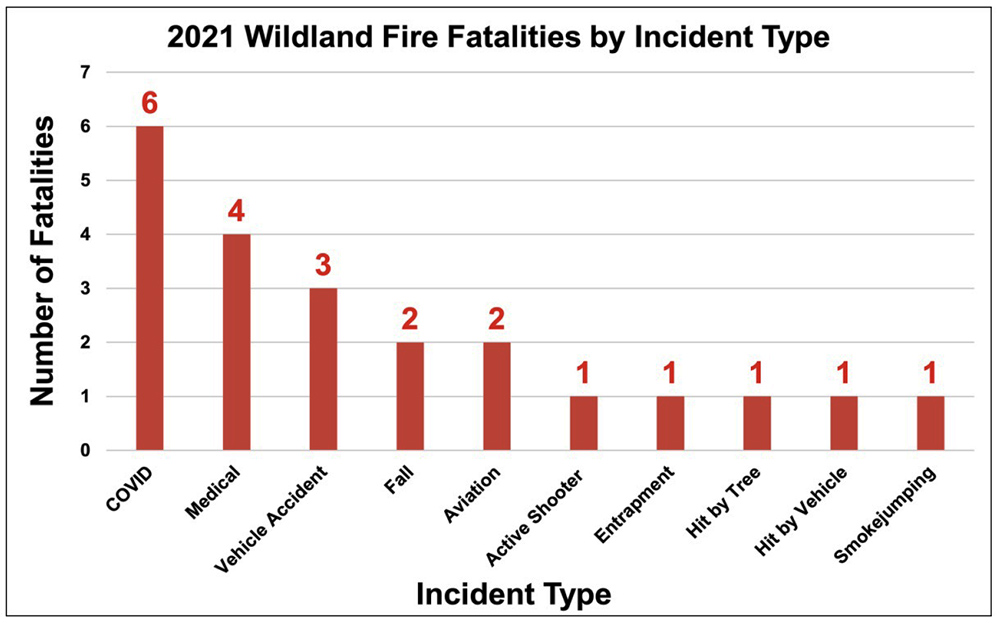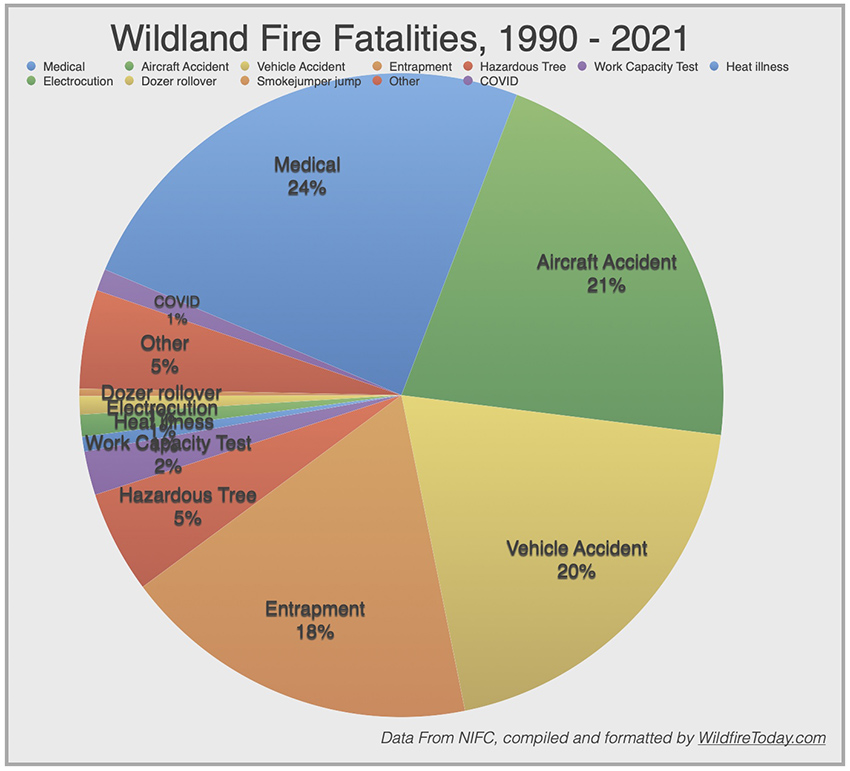
The Wildland Fire Lessons Learned Center (LLC) has released their annual review of incidents from last year, 2021.
The 10-page report discusses lessons learned from seven categories of injuries; dozer swamper, entrapment during initial attack, tree strike, entrapment during a burnout operation, crew vehicle rollover, hazard tree removal, and water tender rollover. It also mentioned other injuries — medical, feller-buncher, ATV rollover, drip torch, falling trees, rolling rocks, and dozer.
COVID was the leading cause of deaths on wildland fires in 2021
The LLC report states there were 23 fatalities, Line of Duty Deaths (LODD), connected to wildland fires in 2021. Six of those, 26 percent, were caused by COVID. That word appears twice very briefly in the report — in a chart showing COVID was the leading cause of Line of Duty Deaths on fires, and, in a word cloud showing that “COVID” was the single word mentioned more than any others in LLC incident reports in 2021. Other than that it is missing in the 2021 Incident Review Summary in spite of the six fatalities from the disease. It is not perfectly clear if the four fatalities described as “medical” had any relationship to COVID.
This annual report would have been an excellent opportunity for the LLC to summarize the most important lessons learned from COVID among firefighters over the last year. It could have identified innovative and successful methods for preventing fatalities and life-altering long-COVID, as well as policies that were not effective. It could have included important facts such as how many worker-days were spent in COVID isolation or quarantine on fires, how many firefighters tested positive during their fire and non-fire duties, and how many tested positive and were hospitalized.
If you go to the LLC website, if the database for reports is working and if you can master the search system, a person might find four reports from the summer of 2021 about “clusters” of COVID among hotshot crews, fuels modules, and engine crews. A total of 52 in these four clusters had to be quarantined and 14 tested positive. We summarized them in an August 21, 2021 article. There is no indication that these were the only COVID “clusters” in 2021.

On the Cameron Peak Fire in 2020 west of Fort Collins, Colorado 76 workers at the fire tested positive for the virus and a total of 273 had to be quarantined at various times over the course of the fire. Two were hospitalized. And this is just at one fire.
I searched the LLC for COVID LODDs, but was disappointed to find there were only very brief boiler-plate firefighter fatality notifications from the U.S. Fire Administration (USFA). There were no identified lessons learned. I found out last year that in some cases the USFA was not afraid to identify the actual cause if it was COVID, when the federal agencies will sometimes, if they mention a cause at all, will just list it as an “unspecified illness.”
The USFA released the information that Allen Johnson was exposed to COVID-19 on the French Fire in California last year and tested positive along with others. His positive test was on August 24, and he was then placed in isolation at the incident. He was transported to the hospital on Aug. 31, 2021 where he passed away that day. That is not a typo. He died same day he was admitted to the hospital.
Fatality rates for COVID and influenza in the United States
We have all heard people say that COVID is just like the flu, people die from both. According to data from the New York Times retrieved February 9, 2022, 907,500 people in the U.S. have died from COVID, which is about 0.3 percent of the population. With 76,961,143 reported cases, that works out to a fatality rate for the disease of 1.2 percent.
During the 2019-2020 influenza season, the estimated number of deaths in the United States from influenza was approximately 20,000, or 0.06 percent of the population. The estimated number of people in the United States symptomatic of influenza was approximately 20,000,000, which would be a fatality rate for the disease of 0.1 percent. (These influenza statistics are from Wikipedia.)
The United States does a terrible job of accurately tracking COVID testing and fatalities, so these stats should be taken with a grain of salt.
Delays in releasing lessons learned reports
It is taking longer and longer for the US Forest Service to release reports about fatalities and near fatalities.
- Burnover of 15 firefighters at a fire station on the Dolan Fire: 17 months.
- Helicopter crash, 1 fatality and 2 serious injuries on a prescribed fire: almost three years.
How is COVID affecting federal firefighters?
I asked the US Forest Service several questions by email about their firefighting forces, including, what percentage of firefighters are vaccinated, how many have been terminated because they are not vaccinated, how many have been hospitalized with COVID, and how many people assigned to fires managed by the FS have tested positive while assigned to the fire and then died from COVID?
The response came from the Forest Service National Press Office. The person who wrote it was not identified. The office refused to disclose any of the numbers requested. “Reporting deaths if an employee dies outside of the workplace is voluntary,” they wrote. “The FS does not track how many employees have been hospitalized.”
Due to a court order, enforcement and disciplinary actions associated with non-compliance with the vaccine mandate for federal employees have been placed on pause. The Department of Justice appealed the preliminary injunction to the Fifth Circuit Court of Appeals, but it remains in place at this time. The Forest Service said employees who received a proposed suspension were officially notified of the pause. The injunction also pauses the requirement for new employees to provide COVID vaccination documentation prior to onboarding as a condition of employment.
Our take
The Forest Service appears to not be committed enough about workplace safety to even keep track of all of their personnel who are killed due to exposure to COVID while working for the agency. Or if they do keep track, they are lying when they report they don’t have the data. A motive for not caring or for hiding the fatality information is difficult to imagine.
A rational person would think that it is astonishing that Allen Johnson remained in isolation at the incident for eight days after testing positive, and then died the day he was admitted to a hospital. Hopefully an investigation is underway. Lives are at stake. What treatment, if any, did he receive at the fire or in isolation? Was he seen there by a doctor? Has the Medical Unit Leader been interviewed? Where was he isolated — in a tent at the fire, or a motel? What was his condition when he was admitted to the hospital? There were others at the fire who tested positive according to the USFA. What are their stories? I fought fires with Allen, so I would like to know more and how to prevent this from happening to other firefighters. Surely there are many lessons to be learned from this and other COVID-related tragedies.
The Forest Service needs to develop the courage to do the right thing for their people. When a firefighter is entrapped on a fire and injured or killed, a team of at least a half dozen subject matter experts will sometimes, but not always, try to honestly figure out what led to the incident and may develop suggestions for preventing others from suffering the same fate. Why are they scared to do the same for the fire personnel that died from COVID last year? Why are they refusing to be transparent about workplace hazards and their people being hospitalized and killed? What is the upside to the secrecy? What are they afraid of?
Already having severe problems recruiting and retaining employees, this type of uncaring management can only make it worse.
If the Forest Service refuses to conduct and release an honest investigation into the line of duty death of Allen Johnson, the chain of command from the Region 5 Director up through the Deputy Chief for State and Private Forestry and the Chief of the Forest Service should be fired.
The charts below cover the 554 fatalities on wildland fires during the 32-year period ending in 2021.











